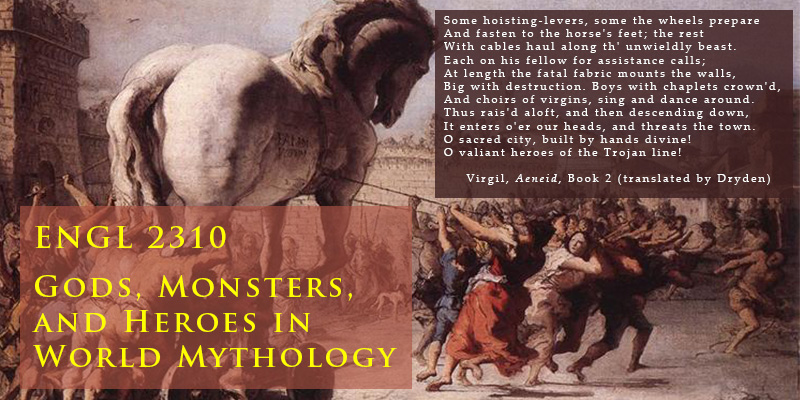Catalog Description
Analysis and interpretation of dominant myths in representative works of world fiction, drama and poetry; critical compositions.
GE C2
Course Description
This course focuses on examining literature as the expression of humanity’s most powerful feelings and convictions through the most effective use of language. ENGL 2310 tends to differ from other lower division English humanities courses in its greater emphasis on the psychological motifs and patterns of symbolic narration that are characteristic of most world cultures. The exploration of common themes in two or three world cultures will enable students to more readily identify culture-based beliefs and appreciate apparently differing beliefs.
The focus on mythology permits students to trace the development of expressions of key social concerns that have shaped literary discourse over a vast period of time and in many human cultures. By myth, teachers of literature refer to narratives that tell of humanity’s origins, quests, trials, or destinies. Through verbal symbols, writers dramatize mankind’s persistent fears and desires, our awe and rapture regarding the mystery of the universe and our existence in it. Myth may define our sense of society as well as ourselves. Myth has been crucial to the literary imagination, for it enables the writer to shape literary material as a public dream on a cosmic scale, showing man’s voyage through crises common to all human life.
Myth has been crucial to the literary imagination, for it enables the writer to shape literary material as a public dream on a cosmic scale, showing man’s voyage through crises common to all human life. Such concerns include the common elements in the Greco-Roman origin myth recorded by Hesiod and its middle eastern analogs, the world-wide myth of a universal deluge, and myths of the Cinderella-motif (with male and female protagonists). Examples could be repeated endlessly. ENGL 2310 traces a handful of central mythic ideas in texts – both ancient and modern, from both western and non-western traditions.
Learning Outcomes
Upon completion of this course, students will be able to:
- understanding that literature and myth provide important records of human experience in all its diversity and variety will help students develop an awareness of the similarities and differences among different cultures in their response to universal themes.
- display knowledge of the differences among literary genres and their relationships to individual cultural contexts.
- recognize that form affects content, and that analysis of the methods, techniques, and structure of literary forms increases the values and pleasures of reading and provides insight into various cultural values and how they are shaped.
- understand how “modern” writers reinvent or utilize “classical,” and universal myths and their themes will develop an understanding of the interactions, relationships, and dependencies among different groups of people; and understand the relevant cultural standards by which mythic themes become works of literature in their own and other societies.
Course Outline
The following sample course outline suggests an intense study of a small number of demanding and richly rewarding texts that have universal literary and cultural appeal.
ETIOLOGICAL:
Hesiod, Theogony (GREEK CREATION MYTH)
Enuma Elish (BABYLONIAN CREATION MYTH)
Snorra Edda (NORSE CREATION MYTH)
HERO QUEST:
Homer, The Iliad, The Odyssey (GREEK HERO ADVENTURES)
Tale of Sinhue (EGYPTIAN ADVENTURE TALE)
Gilgamesh (SUMERIAN/BABYLONIAN ADVENTURE TALE)
Legend of Sargon (AKKADIAN HERO TALE)
Exodus (HEBREW NARRATIVE)
LYRIC:
Ovid, Metamorphoses (ROMAN STAR AND NATURE MYTHS)
Native American Star and Nature Myths
About the Banner: Giovanni Domenico Tiepolo, The Procession of the Trojan Horse in Troy (1773) based on Book 2 of Virgil's Aeneid (image from http://www.wikiart.org/en/giovanni-domenico-tiepolo/the-procession-of-the-trojan-horse-in-troy-1773).
